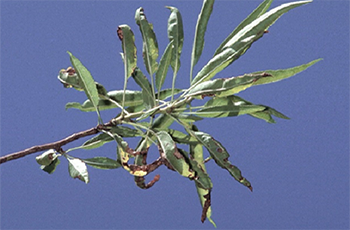
(April 17, 2020) – Almond trees need a variety of different nutrients to thrive, though one of the most important among them is nitrogen. From proper management to understanding the relationship between nitrogen and yield, it’s imperative that growers understand how this element benefits tree health and their productivity each crop year.
Comprehensive nutrient management improves many aspects of tree growth, yield and kernel quality during an orchard’s lifespan. Balanced nutrition, experts say, takes place over many months and should be timed to when the tree most needs it – typically, that’s in mid-March, when at least 70% of leaves are on the tree, and continues in phases throughout the growing season.
Beyond nitrogen, though, two other key nutrients trees are also necessary to maximize trees' productivity – zinc and potassium. As with nitrogen, growers always are advised to keep the four R’s in mind when applying any nutrient or fertilizer:
- Right rate: Match supply with tree demand from all inputs (fertilizer, water and soil)
- Right time: Application must coincide with tree demand and root uptake
- Right place: Delivery must be to active roots, not below the root zone
- Right source: Maximize uptake and tree response and minimize waste
Zinc
Zinc helps trees when cells are dividing and growing, and also is important for next year’s bud set, according to Univeristy of California (UC) Davis professor Patrick Brown, an expert on almond nutrient management. Typically, it is applied via foliar sprays or micro-drip irrigation in the spring.
“Zinc needs to be ‘fed’ to the tree when it is hungry so that it can reach the buds,” Brown explained.
Leaf and soil analysis are important in monitoring zinc needs, Brown said. Leaf values should be at least 20 parts per million (ppm) in the summer, though orchards with readings of less than 30 ppm “will frequently respond to zinc.” In addition, a soil pH level of more than 7.2 can impede zinc uptake. Reducing the soil’s pH from 5.5 to 7.0 via acid injections or ammoniacal nitrogen sources will help with trees’ zinc uptake, and frequent zinc applications via micro-irrigation are the most effective.
Trees that are suffering from a lack of zinc will have small, pale leaves, Brown said. Other symptoms include late bud emergence and erratic flowering. Deficiencies often occur when cold, wet weather in early spring is followed by a warm period, which drives up trees’ zinc demand.
More on zinc demand and foliar application can be found in this published research paper written by Brown, the Almond Board’s Sebastian Saa and UC Davis professor Claudia Negron in March 2018.
Potassium
Potassium is important for development of the hull, shell and kernel. As with nitrogen, Brown recommends applying potassium in multiple smaller applications throughout the growing season. The rate, he said, should be 80 pounds per 1,000 pounds in yield.
Potassium deficiency symptoms often appear in early-to-midsummer and are worst on older leaves of current shoots. Trees also typically show slow growth and smaller leaves, and may produce yields below potential. Low potassium levels often carry over into the following year, “decreasing the number of flowering spurs where trees will set nuts,” as noted by Brown and UC Cooperative Extension farm advisors Katherine Jarvis-Sheen and Joseph Connell in the article “Potassium management for sustained almond yields.”
Leaf analysis is the best way to measure potassium levels and detect concerns early. Brown, Connel and Jarvis-Sheen recommend collecting leaf samples in July because they are “relatively stable at that time.” Potassium levels about 1.4% are “considered adequate.” The trio also states that “higher-than-adequate levels will also help provide ‘back-up’ for heavy set years, which may be especially important to sprinkler irrigated orchards where in-season fertigation to meet higher than usual potassium needs is not effective.”
A balanced approach
Something all growers should recognize, Brown said, is that the right balance of many key nutrients is necessary to optimize a tree’s use of nitrogen. The way to detect balance, he said, is through regular leaf analysis and other monitoring methods (sap analysis, trunk measurements, carbohydrate analysis and soil nutrient status).
“Optimizing nitrogen use efficiency requires optimal management of all inputs,” Brown said. “If any nutrient is undersupplied, yield is lost and response to other elements cannot occur. And if any nutrient is oversupplied, money is wasted.”
And, unlike the weather, nutrient management is something growers can directly impact.
“Nutrient and water management are items that growers control that impact profit, the value chain and protection for the planet,” said Steve Petrie, director of agronomic services for Yara North America. “Nutrient and water management are intertwined. You can’t do one properly without the other.”
For more information on optimal nutrient management, check out this presentation on nutrient management given by Brown, Petrie and others at The Almond Conference 2019 in December.


